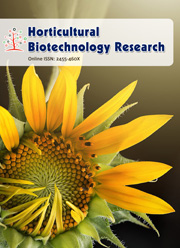Callogenesis and Somatic embryogenesis induction in <em>Hevea brasiliensis</em>: effects of fruit shelf-life and carbon source
Keywords:
callogenesis, carbon source, fruit, Hevea brasiliensis, shelf-life, somatic embryogenesisAbstract
An experiment was conducted to study the effect of the fruit shelf-life and the concentrations of carbon source on somatic embryogenesis via callogenesis of Hevea brasiliensis. Fruits harvested were stored at 15°C during 1, 5, 7, 12 and 15 days and the inner integuments obtained from seed were used as explants. The experiments were performed under carbon source treatments with three concentrations for glucose and five concentrations for sucrose. Under these conditions, the percentage of explants forming calli was better during the first week of fruit preservation regardless of the carbon source but at high concentration. However, beyond 7 days of fruits shelf-life, sucrose is best to induce callus unlike glucose but with high concentration. The best rate of embryogenic calli was also obtained with sucrose. The percentages of callogenic explants and embryogenic calli have decreased sharply with the shelf-life of fruit at 15°C. So, to maintain an embryogenic potential of explants in situations of long-term conservation of fruits, sucrose can be used at 234 mM of concentration or default at 111 mM sucrose. These sucrose concentrations are conducive to induce embryogenic calli with explants coming to rubber fruits after a long time of preservation.Downloads
Download data is not yet available.
Published
15-12-2012
How to Cite
Modeste, K. K., Edmond, K. K., Gilles, K. N., Michel, G., Mongomaké, K., & Hilaire, K. T. (2012). Callogenesis and Somatic embryogenesis induction in <em>Hevea brasiliensis</em>: effects of fruit shelf-life and carbon source. Research in Biotechnology, 3(6). Retrieved from https://updatepublishing.com/journal/index.php/rib/article/view/2346
Issue
Section
Research Articles



 .
.